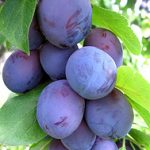
Plums
When to Buy/In Season:
June – October.
How to Select:
Plump, well colored fruit that yields to gentle pressure on the skin. Depending on the variety, color varies from bright yellow-green to reddish-purple to purplish-black. Avoid hard, shriveled, soft, or cracked fruit.
Organic Issues:
Plum trees are susceptible to many diseases, such as plum curculios, brown rot, bacterial cankers, aphids, scale, and other pests, and conventional growers user copious chemicals. Organic methods are available, the most common treatment being sulfur. Check for unsulphured organic plums if you are sensitive to sulfur.
Pesticide Issues:
EWG 2009 Dirty Dozen, #22
How to Store:
Plums ripen at room temperature; the quality is decreased by refrigeration. However, once ripe they should be refrigerated, and will keep for up to 5 days.
Plums release ethylene, which can spoil some produce. Store plums away from:
Bananas
Broccoli
Brussels sprouts
Cabbage
Carrots
Cauliflower
Cucumbers
Eggplant
Lettuce and other leafy greens
Parsley
Peas
Peppers
Squash
Sweet potatoes
Watermelon
Freezer
To Freeze Fresh Plums:
Select firm, ripe fruit soft enough to yield to slight pressure. Sort and wash. Cut in halves or quarters and pit.
Syrup Pack: Pack fruit and cover with cold 40 to 50 percent syrup, depending on tartness of fruit. For improved quality, add 1/2 teaspoon (1500 mg) ascorbic acid to each quart of syrup. Leave headspace. Seal and freeze.
Plum Sauce: Boil well-ripened clingstone plums without water until soft; then remove pits and skins. Continue cooking the pulp and juice until it thickens. Add 1 part sugar (with spices, if desired) to 4 parts plums. Cool and package, leaving headspace. Seal and freeze.
Store frozen plums (0F) up to 8 – 12 months
Canning
See our Basics of Canning Fruit at Home
Home Canned fruits can be stored for up to 1 year; they may lose quality after that point. Commercially canned fruit can be stored up to 3 years.
Drying:
See our Basics of Drying Fruit at Home
To dry sweet plums, wash, cut in half and remove pits, cut into slices, dry at 130-135F. Water content is 87%.
To dry prune plums, wash, cut in half and remove pits. Dry peel side down at 130 – 135F until pliable with no moisture pockets. WAter content of prune plums is 79%.
Store at room temperature up to 6 months; product may easily be frozen.
To keep prunes moist once a package has been opened, remember to keep under cool and dry conditions; away from heat and/or humidity, as well as concrete or brick walls. If you do want to refrigerate prunes, or even if you want to store them for any length of time, be sure that they are in an air-tight container.
To freeze prunes/dried plums: Place in a zip-lock freezer bag, squeeze out the excess air, seal, and place in the freezer. Prunes will thaw quickly, but if you want to ‘speed up’ the process, pour boiling water over the frozen fruit. The heat and moisture will quickly thaw the fruit and it will also help add a bit of extra moisture. Be sure to drain off the excess moisture before using.
Photo Source: greenhem



1 Comment